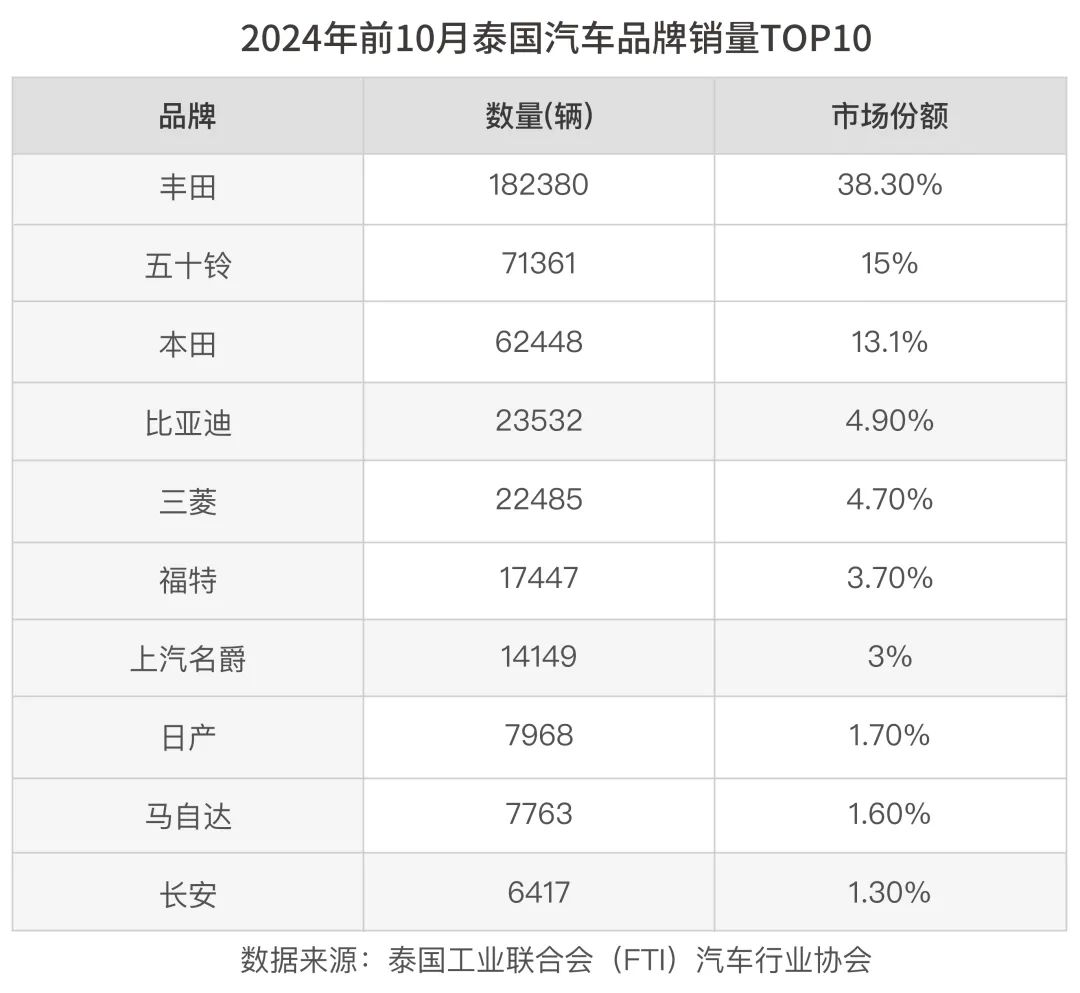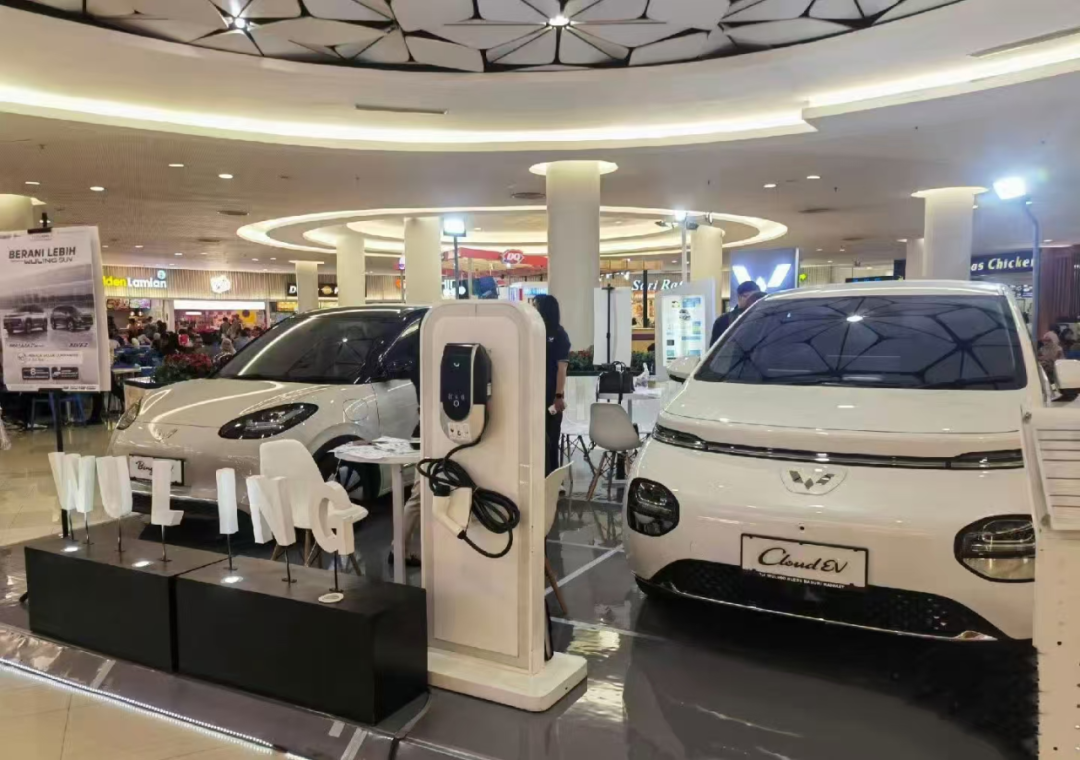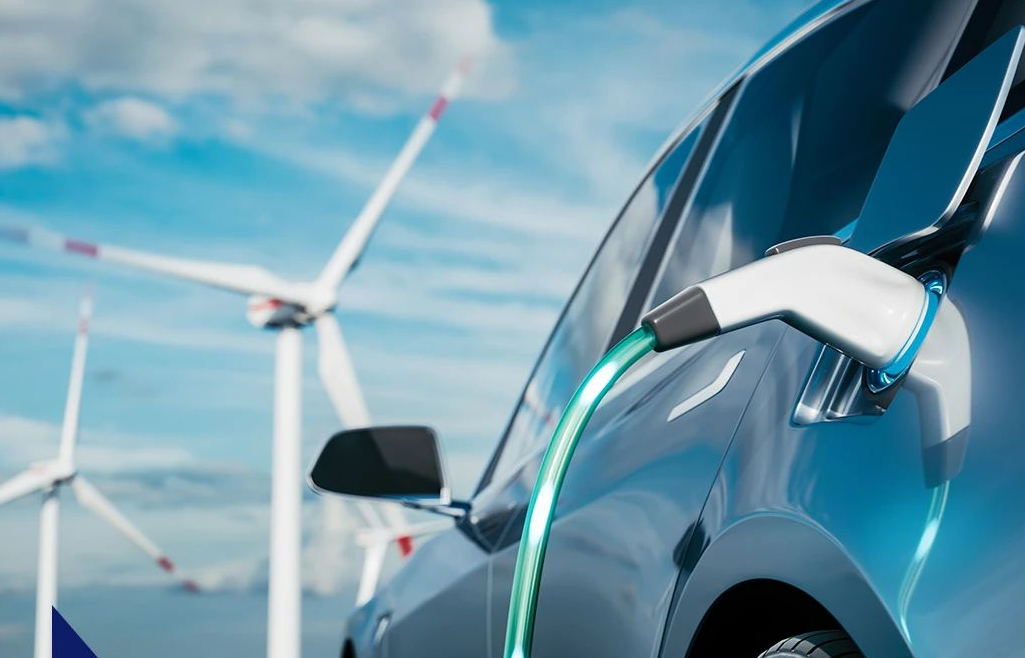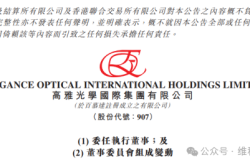Domestic Cars Outshine Japanese Rivals in Southeast Asia
![]() 01/14 2025
01/14 2025
![]() 616
616
Source | YuanMeiHui
Southeast Asia has traditionally been a bastion for Japanese car sales, particularly Toyota and Honda. In Thailand, a country with a significant auto market, Japanese cars have accounted for over 70% of new car sales over the past five years, with Toyota and Honda alone making up more than half of this share. A similar market landscape is observed in Indonesia, Malaysia, the Philippines, Vietnam, and other countries.
However, Chinese brands, often referred to as 'Chinese cars,' are emerging as a rapidly growing force, challenging the dominance of Japanese cars in the Southeast Asian auto market.
Taking Thailand as an example, among the top 10 auto brands in sales from January to October 2024, three Chinese brands stood out: BYD, SAIC MG, and Changan Automobile. Notably, BYD climbed into the top 4 automakers in sales with a market share of 4.9%, up two places from 2023.

In the face of this significant shift, many assume that domestic cars have surpassed their rivals through electrification, but this is only partially true. The rapid growth of Chinese brands in the Southeast Asian market is attributed partly to their refined automotive manufacturing skills and partly to their competitors' lack of innovation.
01
Domestic Niche Cars Become Hits Overseas
Undeniably, new energy vehicles (NEVs) have brought Chinese brands to the forefront of Southeast Asian consumers' attention on a large scale.
Due to the limited competitiveness of local auto companies in Southeast Asian nations and Japanese cars' prolonged neglect of pure electric or plug-in hybrid technology, these regions have had to turn to Chinese brand NEVs to keep pace with the global auto market's electrification trend.
Chinese brand NEVs, which have undergone fierce competition in China, arrive in Southeast Asia with a 'dimensional reduction strike' in terms of product capabilities. Even many models and brands that are lukewarm in China become hits upon reaching these regions. Baojun Cloudy from SAIC-GM-Wuling serves as a prime example.

Image source: DianCheChuHai
As the highest-priced pure electric vehicle from SAIC-GM-Wuling, Baojun Cloudy generated considerable buzz upon its launch in China and was once seen as BYD Dolphin's strongest competitor. However, due to subsequent mismatches in marketing, channels, and other factors, coupled with increasing market competition, Baojun Cloudy has so far only been a 'floating cloud,' with average monthly sales of only a fraction of BYD Dolphin's despite being on the market for over a year.
However, in May 2024, after SAIC-GM-Wuling introduced Cloudy to the Indonesian market, a completely different scenario emerged. According to official data, Cloudy had accumulated over 600 orders before its launch. For reference, Indonesia sold an average of about 2,900 pure electric vehicles per month from January to August 2024.
Therefore, Cloudy, which debuted with over 600 orders, can be said to have peaked right from the start, and its peak period has been quite long. Additionally, according to industry data, Cloudy has consistently ranked among the top 3 best-selling NEVs in Indonesia since its launch.
It's crucial to note that Cloudy is not a budget car in the local market. Cloudy's starting price in Indonesia is 398 million Indonesian rupiahs, equivalent to about 180,000 yuan. In the local market, the same price can also buy mid-range models from Toyota and Honda.
Cloudy's popularity in Indonesia not only signifies local market recognition of Chinese NEVs in terms of product capabilities but, more importantly, it demonstrates that Chinese brands now have the perception to support relatively high prices in the local market. Moving beyond sole reliance on low prices to compete for the market is the foundation for Chinese brands to further capture market share in Southeast Asia.
It's worth mentioning that after Cloudy was rebranded as MG and launched in India in September 2024, it quickly became the local sales champion for NEVs. Additionally, SAIC MG MG4 and BYD Seal are similar cases – they were relatively unknown in China but became hits in Southeast Asia.
02
Impressive Performance Beyond Electric Cars
Many may argue that Chinese brands are 'overtaking on a curve' by competing with Japanese cars in the Southeast Asian market with NEVs, but in reality, Chinese brands are also gaining increasing recognition in the 'straight path' of fuel vehicles. Proton, 49.9% owned by Geely, is a quintessential example.
2018 marked the first full calendar year after Geely acquired a stake in Proton, with Proton's sales volume standing at 64,744 units. Over the following six years, Geely gradually introduced the complete vehicle platforms and technologies of models such as the Binyue, Boyue, and Haoyue to Proton. By 2023, Proton's sales volume had soared to 154,611 units, roughly one-fifth of Malaysia's annual new car sales.
'Six years have passed, and this car (Proton X70, based on the Geely Boyue) is now well-known throughout Malaysia, with 100,000 units sold,' Proton CEO Li Chunrong said at a media symposium in May 2024. He added that Geely's introduction of popular domestic models to the Malaysian market through Proton was the key to the resurgence of this local Malaysian brand.
'Our other car (Proton X50, based on the Geely Binyue) has also sold over 100,000 units in three years,' Li Chunrong further noted.
Whether it's the Proton X50, X70, or the latest X90, as fuel vehicles, they offer no less than Japanese cars of the same class in terms of driving experience and product durability, which is just the foundation. Their continuation of the configuration advantages of Chinese brand models in terms of intelligence is a dimensional reduction strike against Japanese competitors.
According to a YuanMeiHui review, intelligent human-vehicle interaction functions such as remote start and voice control are available in Proton models priced below 100,000 Malaysian ringgits (Note: Malaysian currency, 1 Malaysian ringgit ≈ 1.63 yuan). While these functions are not strictly necessary, they significantly enhance the driving experience. For similar functionality in Japanese competitors, the car purchase budget almost needs to double.
03
'Rolling Away' Low-End Japanese Cars
Whether it's NEVs or fuel vehicles, Chinese brands are displaying an upward trend in the Southeast Asian auto market. In contrast, Japanese cars in the Southeast Asian auto market have been significantly impacted.
According to a YuanMeiHui review, except for Vietnam, which favors Korean cars, and Malaysia, where local auto brands are well-recognized, the best-selling cars in major Southeast Asian countries such as Indonesia, Thailand, and the Philippines are primarily Japanese, focusing on cost-effective models. Most of these popular Japanese cars in Southeast Asia have been marginalized or even unseen in the Chinese market due to their extremely outdated product competitiveness.
Toyota Avanza, the best-selling model in Indonesia in 2024, has a price equivalent to about 110,000 yuan. At this price in China, one can purchase new cars such as the Geely Xingjian 7 or Wuling Xingguang S according to the guide price. If one desires a large space and multiple seats like the Toyota Avanza, there are also MPVs such as the Wuling Kaijie or Maxus G50 to choose from.
Without exception, the aforementioned Chinese brand models offer higher-level configurations inside and out compared to the Toyota Avanza.
Taking the engine specifications as an example, the Toyota Avanza is equipped with a 1.3L naturally aspirated engine, which is reliable but lacks any other notable features. With a maximum horsepower of only 98, there should not be high expectations for the car's power; and as a seven-seater, it may appear 'underpowered' when carrying more passengers, with the engine roaring but the vehicle not moving, and fuel consumption also rising.
In summary, Japanese cars have been popular in Southeast Asia for many years due to their product characteristics that excel in improving space utilization and overall vehicle durability, which align with market demand. On the other hand, except for Malaysia, other countries lack influential local auto brands, and market competition is relatively low. Coupled with the CKD (Complete Knock Down) production model of importing parts and assembling locally, Japanese cars have the dominant power in pricing and product capabilities in Southeast Asia, making it challenging for European and American auto companies to penetrate.
However, Chinese auto companies are different. 'Rolling' in price and product capabilities is precisely their strength. To demonstrate 'sincerity,' automakers including Geely, GAC AION, BYD, Great Wall, Wuling, Nezha, and others have successively invested and built factories in Southeast Asia in recent years, and many of their Southeast Asian factories are already in production.
At the same time, unlike Japanese automakers that generally adopt the CKD production model in Southeast Asia, Chinese automakers are actively deploying a full-chain vehicle manufacturing model in the region. For instance, Geely's investment in Proton's production base in Malaysia and Great Wall's production base in Rayong, Thailand, have completed a complete closed loop of vehicle manufacturing, becoming bridges for them to further expand their products throughout Southeast Asia.

With the continuous development of Chinese automakers' factories in Southeast Asia, it's inevitable that more popular 'Chinese cars' will be introduced to the local market. If Japanese cars in the Southeast Asian auto market do not make substantial changes, the scenario of losing their basic market share in the Chinese market may repeat itself.

Some images are quoted from the internet. Please inform us for deletion if there is any infringement.







